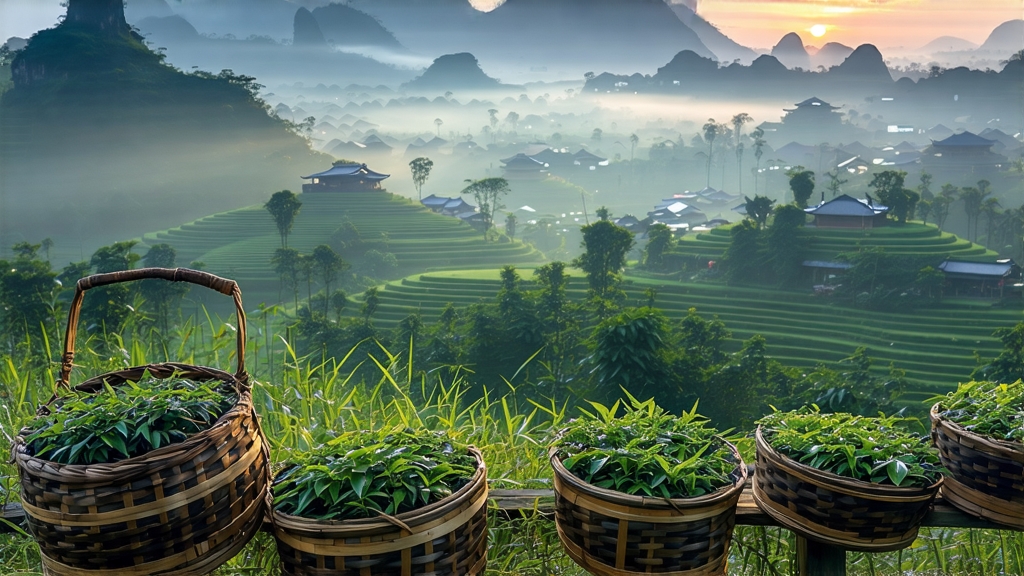
Tucked away in the humid, karst-pocked mountains of southern Guangxi, Liu Bao tea has spent four centuries quietly fermenting while its more famous cousins—Pu-erh, Fu brick, and Qianliang—stole the international spotlight. Yet for those who crave depth over dazzle, Liu Bao offers a liquid time-capsule: a tea that was once ballast for rice traders, currency for border tribes, and medicine for river boatmen, now re-emerging as the sleeper hit of the post-fermented dark tea family.
History: From Ballast to Boutique
The story begins in the small county of Cangwu, Wuzhou prefecture, where the Liu Bao (literally “Six Forts”) basin meets the Xun River. During the Ming dynasty, pressed tea leaves were loaded onto bamboo rafts as counterweight for rice barges heading to Guangzhou and Hong Kong. The humid hold, river mist, and tropical sun conspired to oxidize the tea far beyond ordinary green or oolong. By the time the cargo reached Southeast Asia, the leaves had turned chestnut-brown, their flavor mellowed into a sweet, earthy liquor that cooled feverish bodies and settled seasick stomachs. Malay tin miners dubbed it “Kampo” tea, and it became a breakfast staple from Penang to Medan. When the British East India Company rerouted trade in the nineteenth century, Liu Bao followed diasporic Cantonese communities, quietly embedding itself in kopitiam culture while Europe fixated on Indian black teas. Only in 2008 did the Chinese government grant Liu Bao national geographical indication status, sparking a renaissance that now sees small-batch, vintage-dated cakes selling at London tea auctions alongside first-growth Bordeaux.
Micro-Terroirs within One Valley
Liu Bao is not a single cultivar but a mosaic of ancient seed-grown trees scattered across six historical stockades—Tongping, Xianyi, Bugang, Lilin, Gongzhou, and Siping—each separated by no more than ten kilometers yet differing in altitude, soil pH, and fog density. The highest gardens at 800 m produce leaves rich in amino acids, yielding a honeyed fragrance reminiscent of longan fruit; lower terraces at 300 m give tougher leaves with higher polyphenols, ideal for the strenuous wet-piling process. Connoisseurs speak of “mountain charm” (shan yun) versus “river charm” (shui yun), a sensory shorthand for whether the tea carries crisp camphor notes from rocky ridges or silky jujube sweetness from alluvial banks. In between, micro-gardens of wild white-blossom tea trees (Camellia sinensis var. assamica) are still harvested by the Yao minority, who believe the leaves absorb the spirit of the silver pheasants that nest beneath them.
Crafting Liu Bao: The Double Dance of Water and Fire
Fresh leaves are picked in late April when two leaves and a bud still wear their spring down. After a brief outdoor withering, they are sent to a “water alley” (shui xiang), a covered courtyard where giant woks heated to 280 °C perform a 3-minute sha qing (kill-green) that locks in a faint bamboo-green tint. Rolling follows, but unlike green tea’s tight spirals, Liu Bao strips are twisted just enough to crack cell walls for future microbial access. The signature act is wet piling (wo dui), Guangxi’s answer to Yunnan’s raking of Pu-erh: the leaves are sprayed with mineral-rich spring water, stacked 70 cm high under hemp canvas, and left to ferment for 45–60 days. Internal piles reach 62 °C; every five days a barefoot worker “walks the pile,” turning the heap to aerate and rehydrate. The result is a bloom of Eurotium cristatum—the same “golden flower” prized in Hunan Fu brick—visible as yellow freckles on finished leaves. Finally, the tea is steamed, pressed into 40 kg bamboo baskets lined with wild banana leaf, and transferred to underground caves where relative humidity hovers at 85 %. Here it naps for a minimum of three years, during which slow oxidation and microbial fermentation flatten astringency and generate the trademark betel-nut aroma (bin lang xiang), a sweet-spicy note that perfumers compare to dried figs and nutmeg.
The Art of the Basket: Aging without Oak
Unlike Pu-erh cakes that age in dry